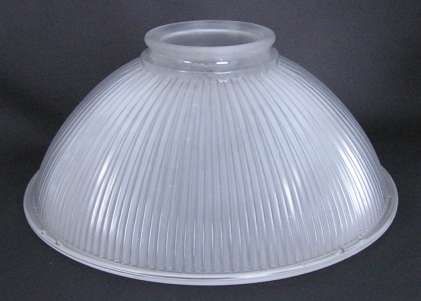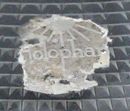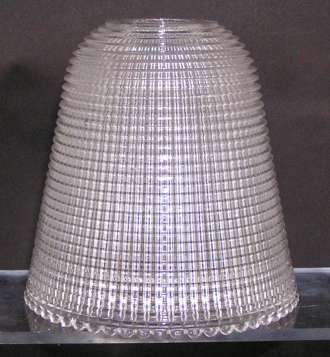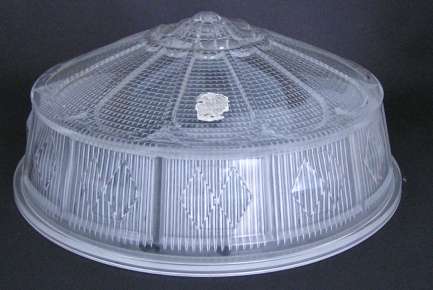|
|
|||||||||||||||||||||||
|
|||||||||||||||||||||||
|
Blondel and Psaroudaki patented their idea in France, the USA and the UK. The UK patent was submitted on the 12th October 1893. The patent, No 19185, for Lamp Globes states:
|
Their Holophanous globe had vertical internal flutings and horizontal external flutings, the forms of which were calculated such that each part of the globe sends some light to all parts of the space surrounding the light source. They were also designed to reduce the loss of light caused by absorption and internal reflections in the glass itself.
 The Holophane product was very successful and in 1895 the rights
to the Holophane product were bought by a remarkable and forward-thinking man -
Otis A Hygatt. He started the Holophane Company in London and the Holophane
Glass Company Inc. in New York. This new company immediately started to register
designs for new prismatic shades. In the USA a Lighting laboratory was
established. This was the first laboratory to develop methods of measuring both
the intensity and distribution of light. In 1906 they demonstrated the Dibden
photometer. This could measure the intensity and distribution of light from any
lighting source no matter how large or complicated. Using this system they
became the first company to supply users with photometric curves which showed
the user what they could expect from a lighting unit. In 1906 they also founded
the Illuminating Engineers Society. The Holophane product was very successful and in 1895 the rights
to the Holophane product were bought by a remarkable and forward-thinking man -
Otis A Hygatt. He started the Holophane Company in London and the Holophane
Glass Company Inc. in New York. This new company immediately started to register
designs for new prismatic shades. In the USA a Lighting laboratory was
established. This was the first laboratory to develop methods of measuring both
the intensity and distribution of light. In 1906 they demonstrated the Dibden
photometer. This could measure the intensity and distribution of light from any
lighting source no matter how large or complicated. Using this system they
became the first company to supply users with photometric curves which showed
the user what they could expect from a lighting unit. In 1906 they also founded
the Illuminating Engineers Society. |
Holophane were not manufacturers, they designed and sold prismatic glassware. All of their production was made locally by established glass manufacturers. A high degree of skill was required to make the moulds for prismatic shades, as the prisms were very small and had to be shaped to a very high degree of precision. In the UK they turned to the George Davidson Company to make their shades. Davidson's own records state that the first moulds for Holophane was made on 23rd July 1896 and that they had been making shades for Holophane for a short while before hand. The relationship with Holophane was to last well over 60 years.
|
The majority of glassware made for Holophane by Davidson was in clear or frosted flint glass. Some shades were made in SILBO toughened glass and some lens and roof lamps etc in FERLUX (a semi-opaque glass). |
Davidson were not the only company to supply prismatic glassware to Holophane. Chance Brothers also had a contract with Holophane. Holophane were keen to ensure there was no undue price cutting in the prismatic glass world. The contract with Chance Brothers was implemented such that Chance would not bid for other prismatic business providing Holophane gave them an agreed amount of business each year. In 1937 the General Electric Company approached Chance to make prismatic glassware for them. The agreement with Holophane prevented them, although Holophane had not supplied the agreed amount of business to Chance. As Davidson also made glassware for GEC, Holophane were concerned that price cutting would occur.
An agreement was reached whereby Chance were released from their Holophane contract as far as GEC were concerned, providing that they would not quote a lower price for the work than Davidson. Davidson, Chance and Holophane agreed to this proposal, regarding it as a means of preventing dangerous competition between both manufacturers and distributor and ensuring profits were not reduced.
The following year Holophane attempted to apply pressure to Davidson. P English of the Holophane company approached W Balmer, works manager at Davidson, with a request that Holophane should take a financial interest in Davidson, and should Davidson not agree, then Holophane suggested that they would start their own factory to make prismatic glassware in 'Diaha' or other plastic material. This annoyed Claude Fraser, not only the suggestion itself, but the fact it had been made to the Davidson works manager and not to the Davidson Board. Also Balmer had failed to report this approach to the Davidson Board for 3 weeks!
This approach seemed to have soured business relationships between Holophane and Davidson, so much so that in 1939 Claude Fraser had a meeting with W Guy Campbell and other members of the Holophane Board to discuss the business relationship between the two companies. Holophane had proposed that they should be the ones to decide whether Davidson bid for any article of prismatic glassware. Holophane also suggested that they be paid a commission for any work that Davidson did for the GEC. Both of these proposals were rejected by Davidson. Davidson did agree to do everything they could to protect Holophane interests without unduly impacting Davidson's business or relationship with other distributors of prismatic glassware.
 Holophane's business practices bought it into conflict with the
US Government. In 1954 the Supreme Court ruled that Holophane's tight network of
agreements with other manufacturers of prismatic glassware, which allocated
different worldwide territories to different companies, was anticompetitive.
Holophane's business practices bought it into conflict with the
US Government. In 1954 the Supreme Court ruled that Holophane's tight network of
agreements with other manufacturers of prismatic glassware, which allocated
different worldwide territories to different companies, was anticompetitive.
As the Davidson company changed its direction in the 1960s, it stopped making glass for Holophane. Unlike Davidson the Holophane company is still going, and is part of the Acuity Brand of Companies (www.holophane.com). In the past 100 years some of its most notable achievements in the UK have been the design and installation of lighting for the massive Battersea Power Station in London, installation of lighting inside and outside Westminster Abbey for the coronation of King George VI and providing additional lighting in Westminster Abbey for the coronation of our present Queen in 1953.
Holophane Registered Designs
The following table lists the Holophane designs registered in the UK from 1895 to 1940.
| Design Number | Date | Design Number | Date |
|
290582 |
21 December 1896 |
622323 |
15 July 1913 |
|
290847 |
24 December 1896 |
622325 |
15 July 1913 |
|
291934 |
14 January 1897 |
661032 |
11 July 1917 |
|
295426 |
10 March 1897 |
661034 |
11 July 1917 |
|
300657 |
23 June 1897 |
661056 |
12 July 1917 |
|
331416 - 331423 |
23 December 1898 |
735401 |
15 February 1928 |
|
587763 - 587779 |
2 August 1911 |
744013 |
5 March 1929 |
|
592455 - 592468 |
17 November 1911 |
745914 |
24 May 1929 |
|
592470 |
17 November 1911 |
751975 |
5 February 1930 |
|
598216 - 598221 |
16 March 1912 |
779416 |
7 January 1933 |
|
609740 - 609742 |
29 October 1912 |
779545 - 779546 |
11 January 1933 |
|
|
|
|
 Today
Prismatic glassware is part of everyday life, from car headlights to the lamps
which illuminate our environment. Yet the technology is only just over 100 years
old. The idea of using shades with tiny prisms to help direct and magnify a
light source, whether gas, oil or electric was invented in 1893 by the French
scientist Andred Blondel and a Greek engineer Spiridon
Psaroudaki. They patented the idea and founded a company they called Holophane
from the Greek - Holos
- entire, Phane - a torch).
Today
Prismatic glassware is part of everyday life, from car headlights to the lamps
which illuminate our environment. Yet the technology is only just over 100 years
old. The idea of using shades with tiny prisms to help direct and magnify a
light source, whether gas, oil or electric was invented in 1893 by the French
scientist Andred Blondel and a Greek engineer Spiridon
Psaroudaki. They patented the idea and founded a company they called Holophane
from the Greek - Holos
- entire, Phane - a torch).  The Holophane contract was important for Davidson, although the
relative importance was to vary from year to year. For example in 1949 11% of
the Davidson revenue was to come from Holophane. They were Davidson's second
largest single customer. Clayton Mayers were the largest, accounting for 12.5% of
turnover. Davidson did not only make prismatic glassware for Holophane, but also
for other companies. Although 11% of their revenue came from Holophane, 18% came from other lighting
companies. None of the other individual contracts was anywhere near as large as
Holophane.
The Holophane contract was important for Davidson, although the
relative importance was to vary from year to year. For example in 1949 11% of
the Davidson revenue was to come from Holophane. They were Davidson's second
largest single customer. Clayton Mayers were the largest, accounting for 12.5% of
turnover. Davidson did not only make prismatic glassware for Holophane, but also
for other companies. Although 11% of their revenue came from Holophane, 18% came from other lighting
companies. None of the other individual contracts was anywhere near as large as
Holophane.